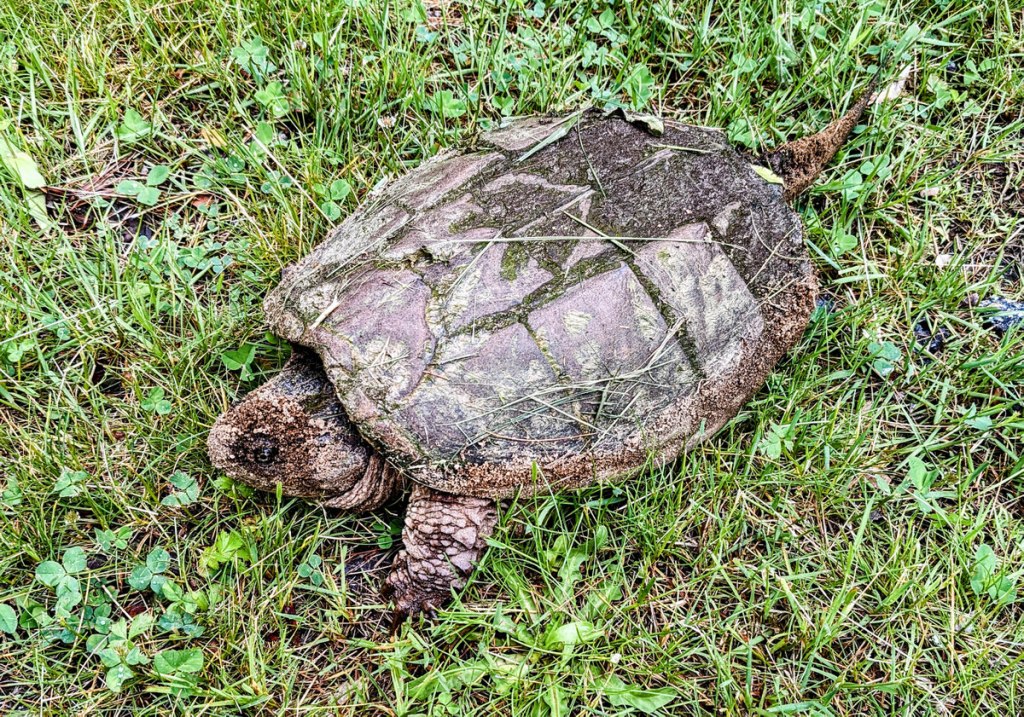
June is when the big female snapping turtles come up out of the ponds and swamps to find some warm sand to lay their eggs in. This one had just done so and still had wet mud clinging to her when I saw her on one of my walks. Egg laying seems to be quite a project for the big reptiles but every year many thousands of eggs are lain, so they always find a way.

Seeing this garter snake might have stopped the snapper in its tracks, because they are omnivores and eat snakes, frogs, fish, crayfish, insects, plants, birds, small mammals, and even other turtles. It was on another walk that I saw this snake and what was really odd about it was how it was out in the open in daylight. They often come out to the edge of the woods to sun themselves during the day but are always within easy reach of cover, and will slither off quickly if you approach them. This one had no cover at all, not even high grass.

I kept trying to get a shot of the snake with its forked tongue out, but I missed every time. Garter snakes are timid and nonpoisonous, so they are nothing to worry about. Still, if my grandmother had been there, she would have been up a tree. Garter snakes eat crickets, grasshoppers, small fish, and earthworms. They do have teeth, but they’re no real danger to humans. I’ve read that the saliva of some garter snake species contains a mild neurotoxin that causes paralysis, making small prey easier to swallow.
While I was taking photos an 85 year old lady stopped and rolled down her car window and told me how she was deathly afraid of snakes but, she said, when she was just a girl she once let them drape a boa constrictor over her shoulders at a circus for a free candy bar. I told her she and my grandmother would have gotten along quite well.
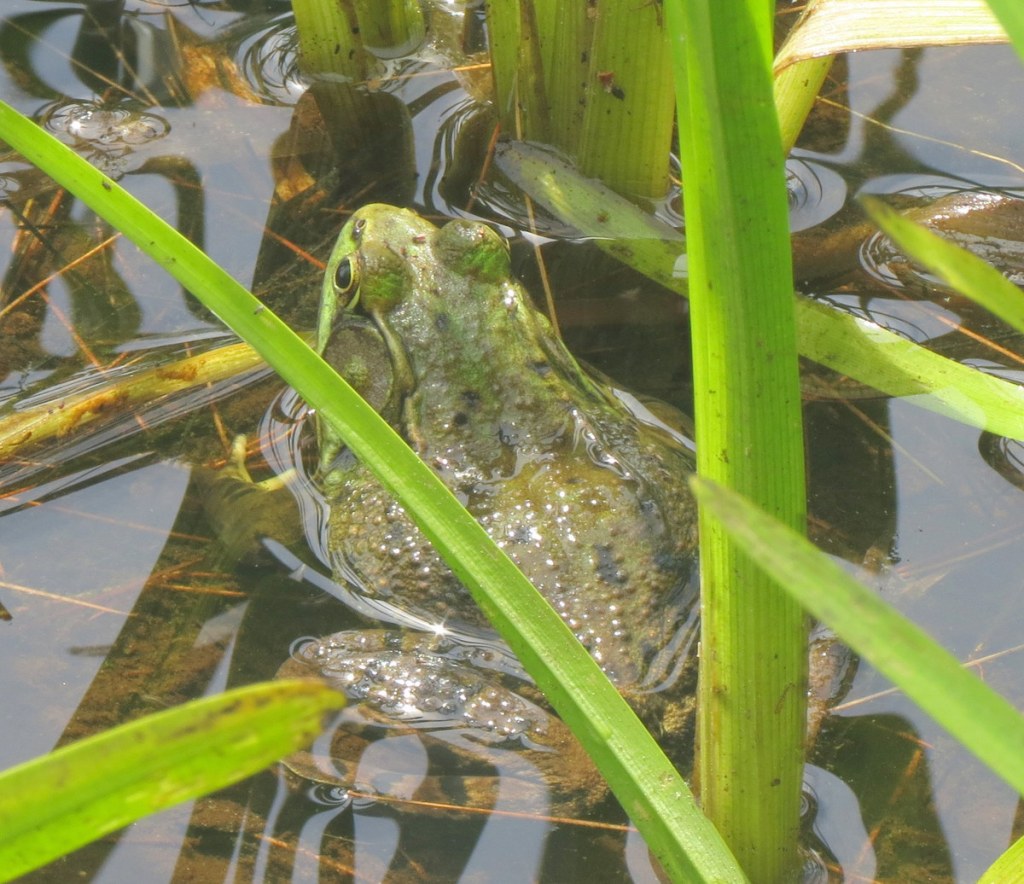
That garter snake probably would have like to have met Mr. bullfrog, but I doubt it could have swallowed him. This was a big frog, but I never would have seen it if it hadn’t croaked loudly after a neighboring frog did the same. They do talk to each other. One will start it off and then they’ll all start croaking, one right after the other. It can be quite loud.

On the same day I saw the frog in the previous shot I saw a bullfrog jump right out of the water and snatch something out of the air before landing with a splash, and I think it might have been a cousin of this spangled skimmer dragonfly. The “spangles” are the black and white markings on its wings, otherwise it closely resembles the slaty skimmer, which is what I thought it was at first. It was quite far away when I took this shot. I also saw lots of pretty twelve spotted skimmers on this day but I couldn’t get a shot of any of them.
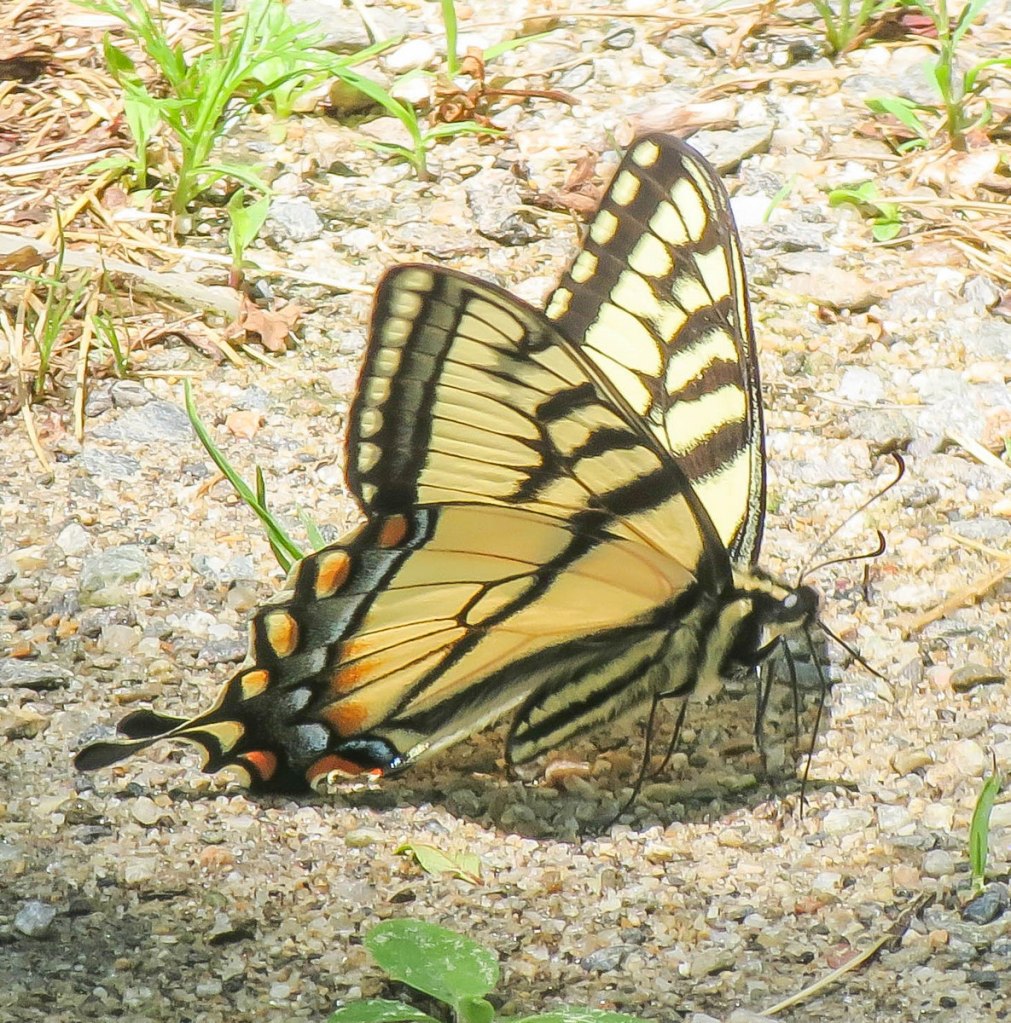
I saw 3 or 4 eastern swallowtail butterflies probing the damp sand at the edge of a dirt road recently. They’re pretty things and at about the same size as a monarch butterfly, big enough to see easily. They often show up just before the mountain laurels bloom and I see them hanging from the laurel flowers almost every year.
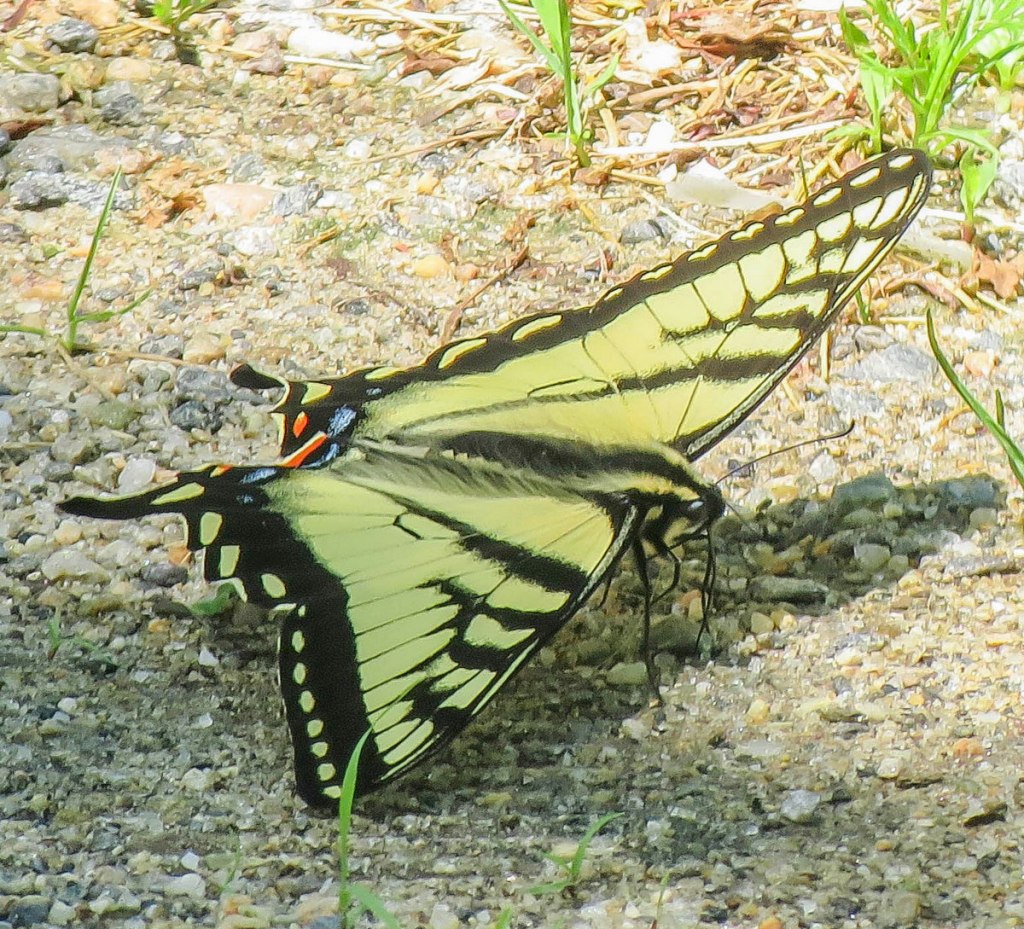
Usually I have to wait for butterflies to fold their wings but this time I had to wait for this one to unfold them. I was hoping it would have more blue/purple on its wings than it did.
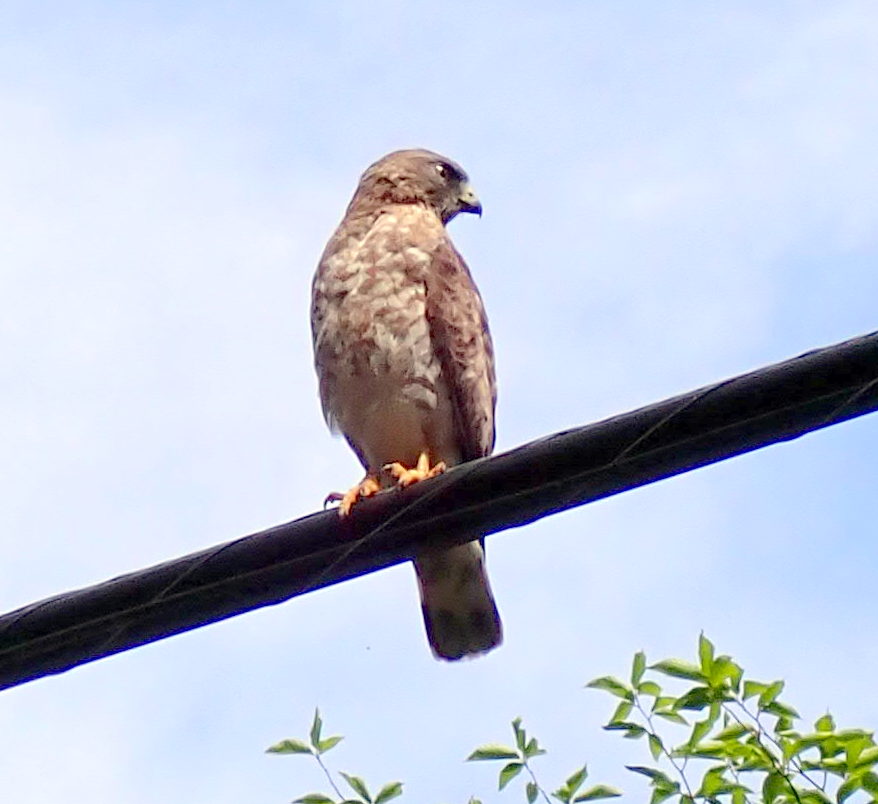
I hike in the woods but I walk on roads, and on one of those walks a hawk flew out of the woods, swooped down right over my head, and landed on a wire ahead of me. I thought as soon as I got too near it would fly off but no, I walked over and stood right under it and it didn’t move. I don’t carry my “big” camera with me when I walk because I walk fast and its constantly bumping into my chest bothers me, so I had to get this shot with my small macro camera. That’s why it isn’t a very good shot, but it does show a hawk. I’m not very good with birds but it might be a cooper’s hawk. If you know what it is for sure I’d love to hear its name because I think it lives here and I’m fairly sure I’ve seen it before.

In this shot I took of the evening sky with my phone camera there was a bird flying up there to the right that I never saw until I looked at the photo. I wondered if it could be a hawk, but the detail isn’t fine enough to tell. It’s just a silhouette.

I saw a familiar sight on an oak branch on a recent walk. Wooly oak galls are usually about the size of a ping pong ball when I find them, but have a kind of felt feel, like a tennis ball. The gall is caused by secretions from the grubs of the wool sower gall wasp (Callirhytis seminator) and they only appear in spring.
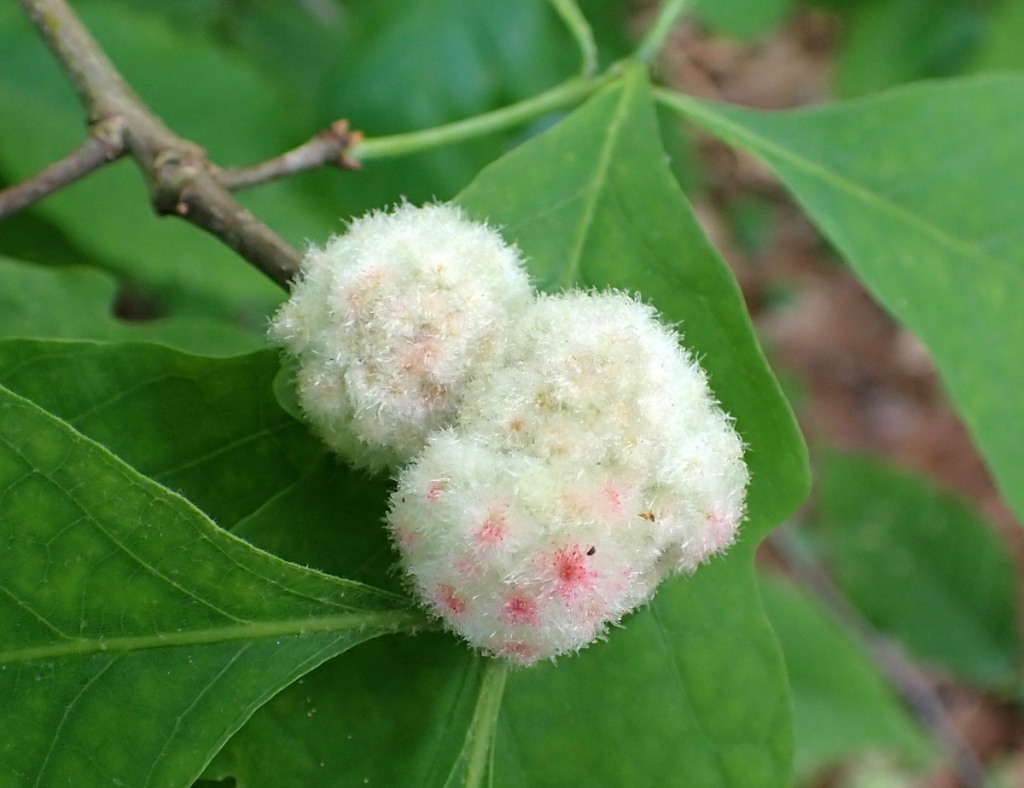
There are small seed like structures inside the gall which contain the wasp larva, and that’s why these galls are also called oak seed galls. What I want to point out about these galls though, is how books will tell you that they will only grow on white oak trees, and that isn’t true. Though they almost always do grow on white oaks I’ve also seen them on red oaks, so don’t be fooled by the galls like I have been; check the leaves. One thing I’ve learned from studying nature is the words always and never do not apply.

White pine (Pinus strobus) pollen cones have come and have opened, and have released their yellow-green pollen to the wind. It settles on everything, and if you leave your windows open you find that it even comes into the house. My car is covered with it but luckily it is like dust and just blows away.
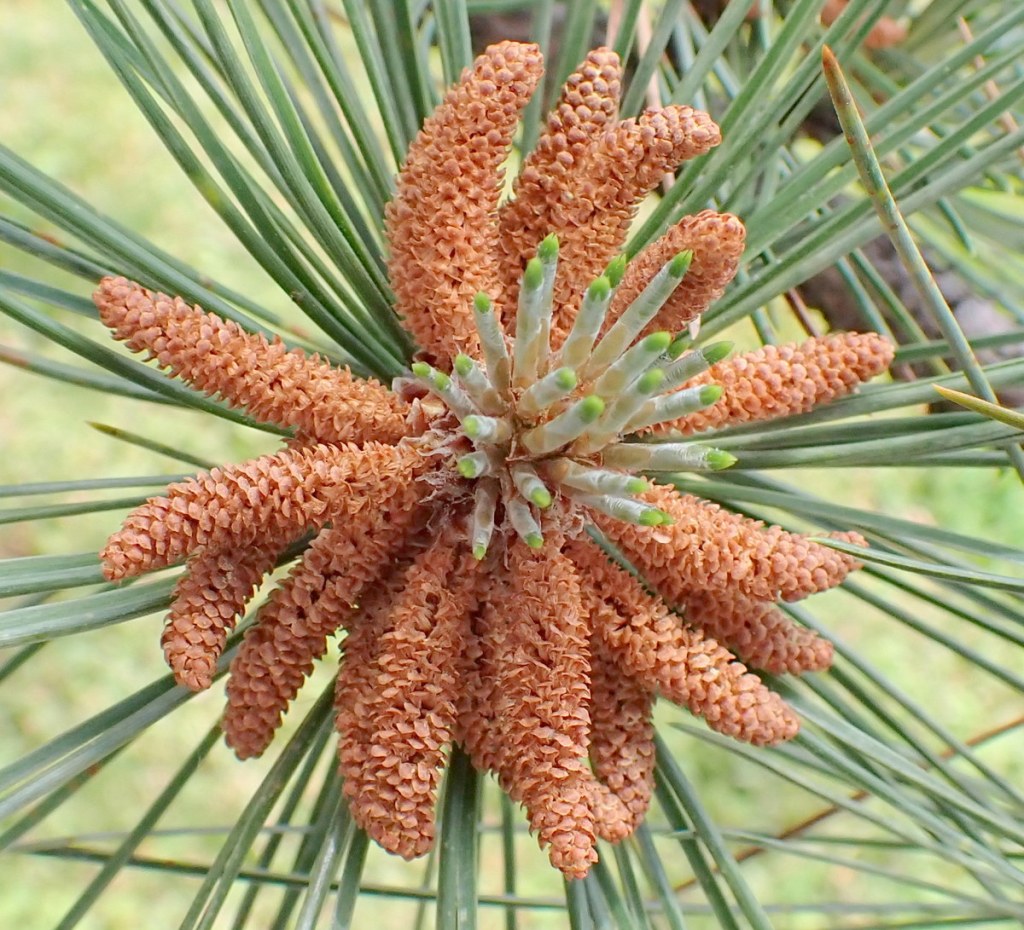
This year I went looking for red pine pollen cones (Pinus resinosa) and the ones I found before they had opened were very beautiful, but they were also in someone’s yard so I didn’t get a shot of them. Then I remembered where there were others that I could get close to and here they are in this photo, but they had already opened. They are much bigger than white pine pollen cones.
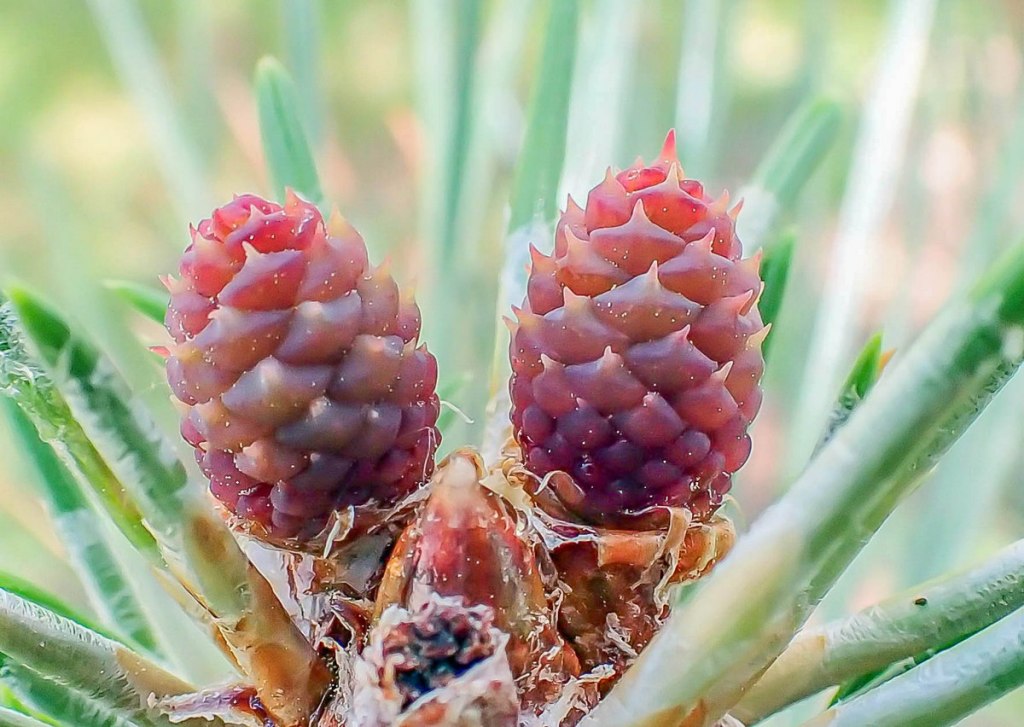
Pollen cones are the male flowers of the tree and this photo shows the female flowers. When the male pollen finds them, if all goes according to plan they will be fertilized and will become the seed-bearing pine cones that I think we’re all familiar with. Some flowers on coniferous trees are very small; so small that sometimes all I can see is a hint of color, so you have to look closely to find them.

The Ashuelot River gets lower and lower and still no beneficial rain comes to refill it. I’m starting to get the feeling that it may not be a good year for mushrooms, but I hope I’m wrong.
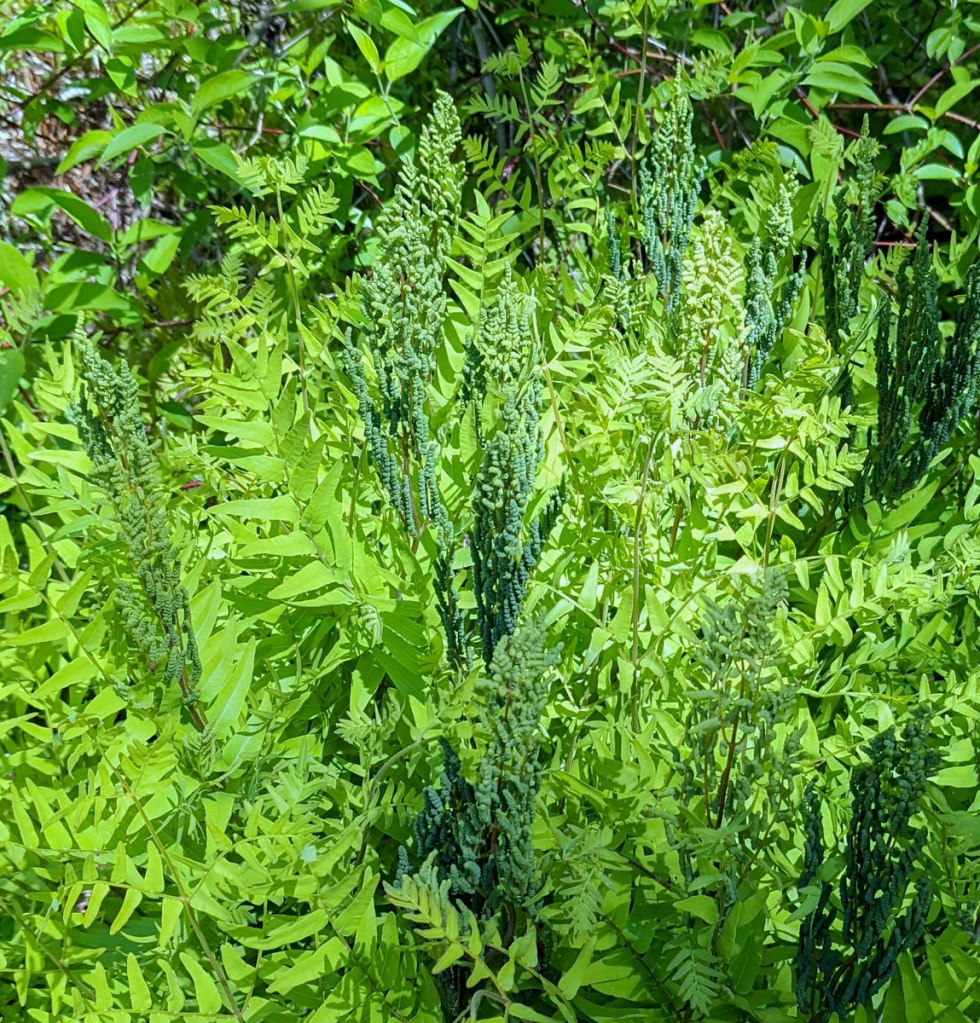
Another name for royal fern (Osmunda spectabilis) is “flowering fern,” because someone once thought that the fertile, fruiting fronds looked like bunches of flowers. You can see them here on the fern in the photo but though they are often purple they don’t look much like flowers to me. Royal fern is the only fern that grows on every temperate continent except Australia, which makes it one of the most widespread of all living species.
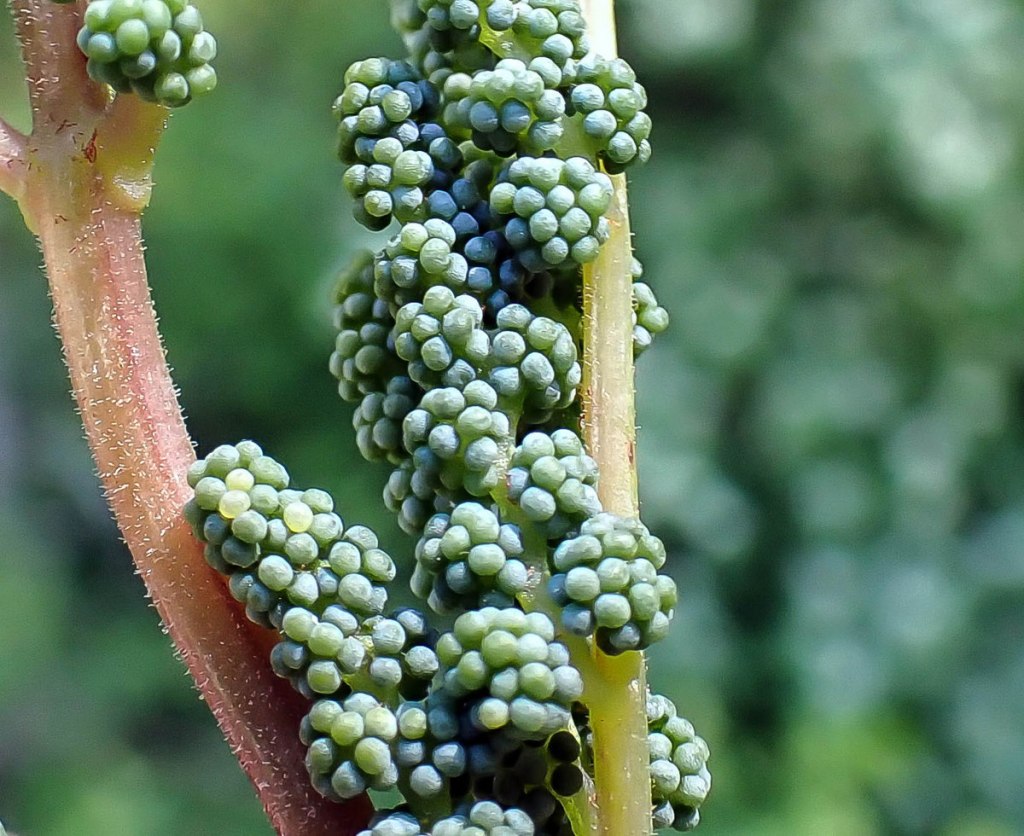
Here is a closer look at the spore capsules of the royal fern. They aren’t something that many people get to see.

For the first time, this year I was able to find and get a shot of a royal fern fiddlehead. Even at this stage it’s a beautiful fern. In the fall, at the other end of its life, it will turn first bright yellow and then will become a kind of beautiful burnt orange color.
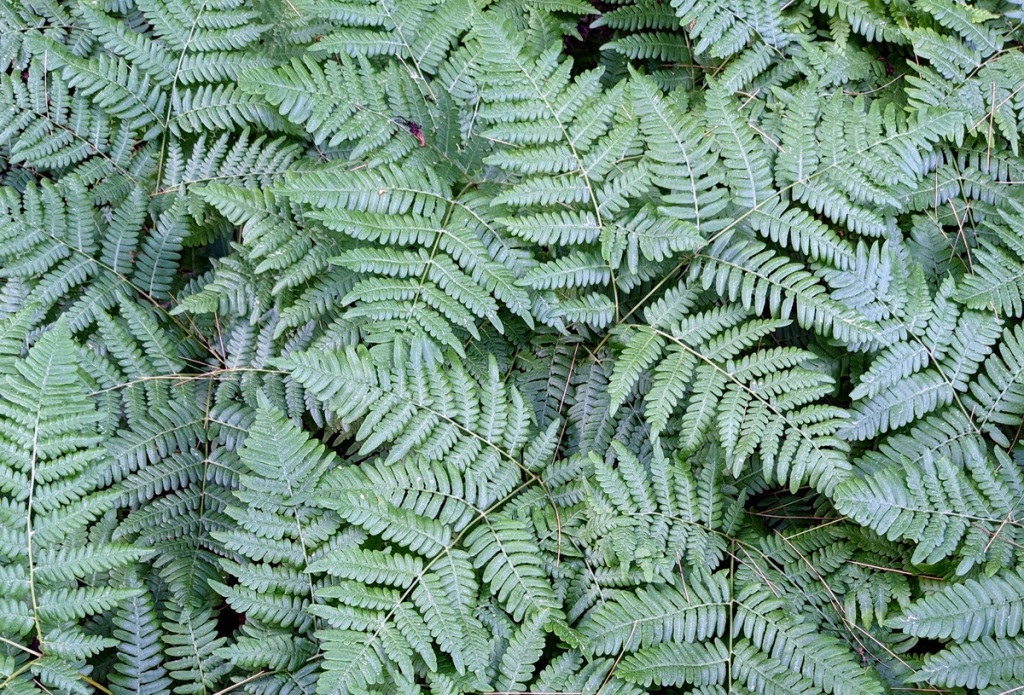
Three bracken fern fronds (Pteridium aquilinum) appear at the end of a long stem and flatten out horizontally, parallel to the ground. They also overlap and shade the ground under them. These growth habits and their ability to release chemicals that inhibit the growth of many other plants means that almost nothing will grow under a colony of bracken fern. They will not tolerate acid rain, so if you don’t see them growing where you live you might want to check the local air pollution statistics.
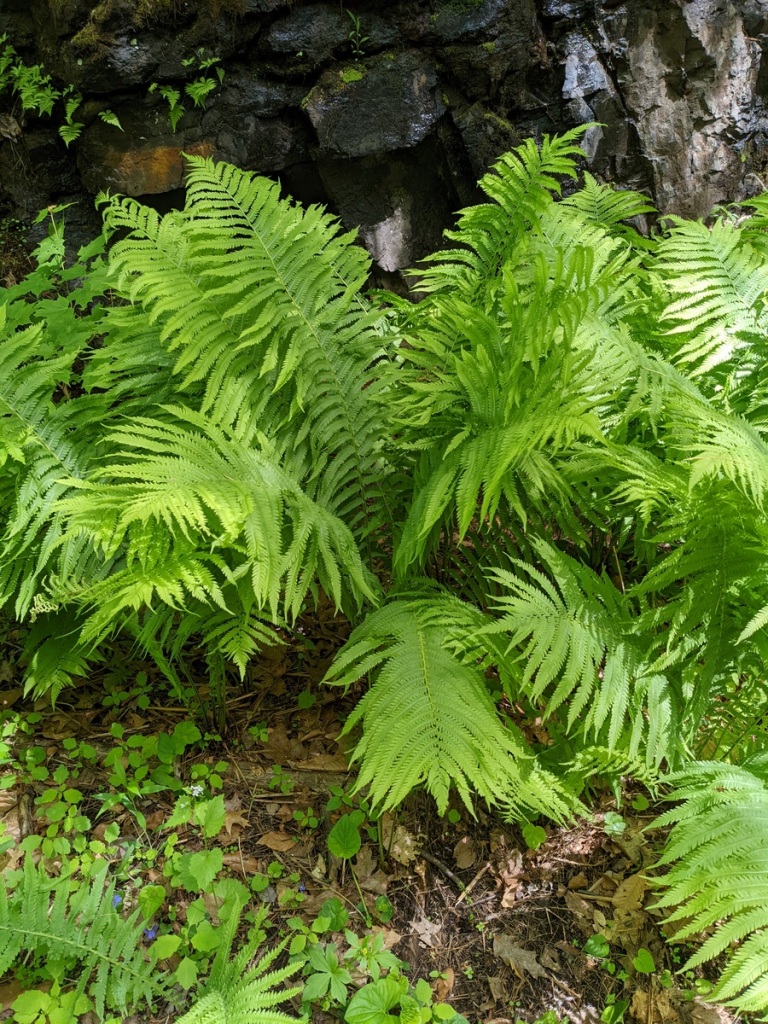
Ostrich fern (Matteuccia struthiopteris) is not a fern that I see a lot of. It likes damp ground and shade but even beyond that it seems to be very choosy about where it grows. It’s a very beautiful fern that I wish I’d see more of.

Ostrich fern fronds are narrower at the tip and base and wider in the center. The leaf stalk of an ostrich fern is deeply grooved, much more pronounced than others. Sensitive, interrupted fern and cinnamon fern have grooved leaf stalks but their grooves are much shallower. If you like to eat fern fiddleheads in spring you should get to know ostrich fern by that groove.
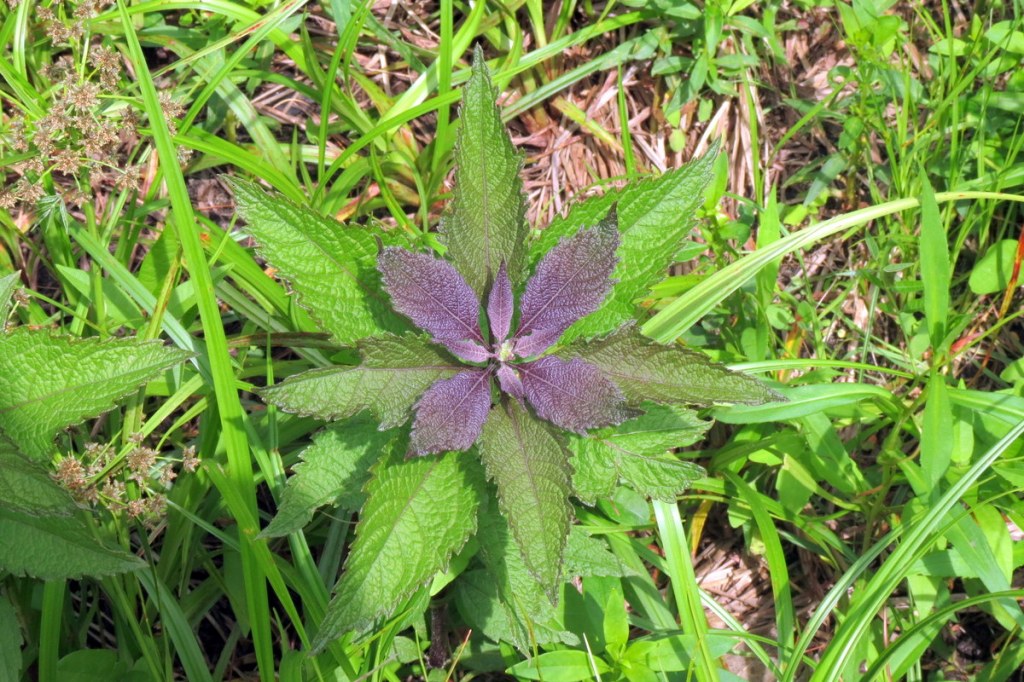
In some plants the same pigments that color leaves in the fall when they stop photosynthesizing also color their leaves in the spring before the leaves have started photosynthesizing. Once they start producing more chlorophyll, they’ll quickly turn green. This coloring of new spring leaves is a form of protection from the weather that some plants and even trees use. Heavy cloud cover, cold snaps, and even too much sunlight can cause some leaves to slow down their greening process in spring, but plants like the Joe Pye weed (Eupatorium) seen in this photo do it almost every year, I’ve noticed.
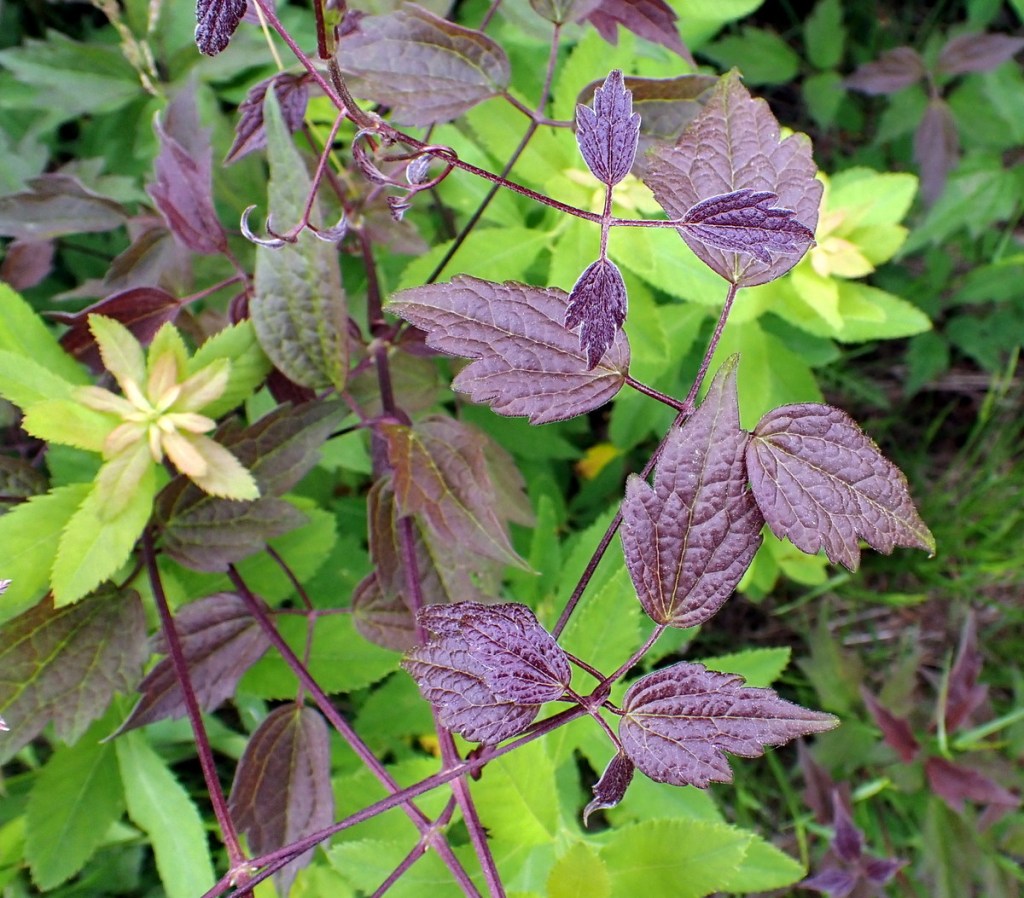
Another plant with purple leaves in spring, every spring in my experience, is the native clematis called virgin’s bower or traveler’s joy (Clematis virginiana). It won’t be long before its small white flowers decorate the roadside shrubs as it climbs over them to reach optimum sunlight but by that time all of its leaves will have turned green. An extract made from the plant is hallucinogenic (and dangerous) and was used by Native Americans to induce dreams. Mixed with other plants like milkweed, it was also used medicinally. It is a very toxic plant that can cause painful sores in the mouth if eaten.
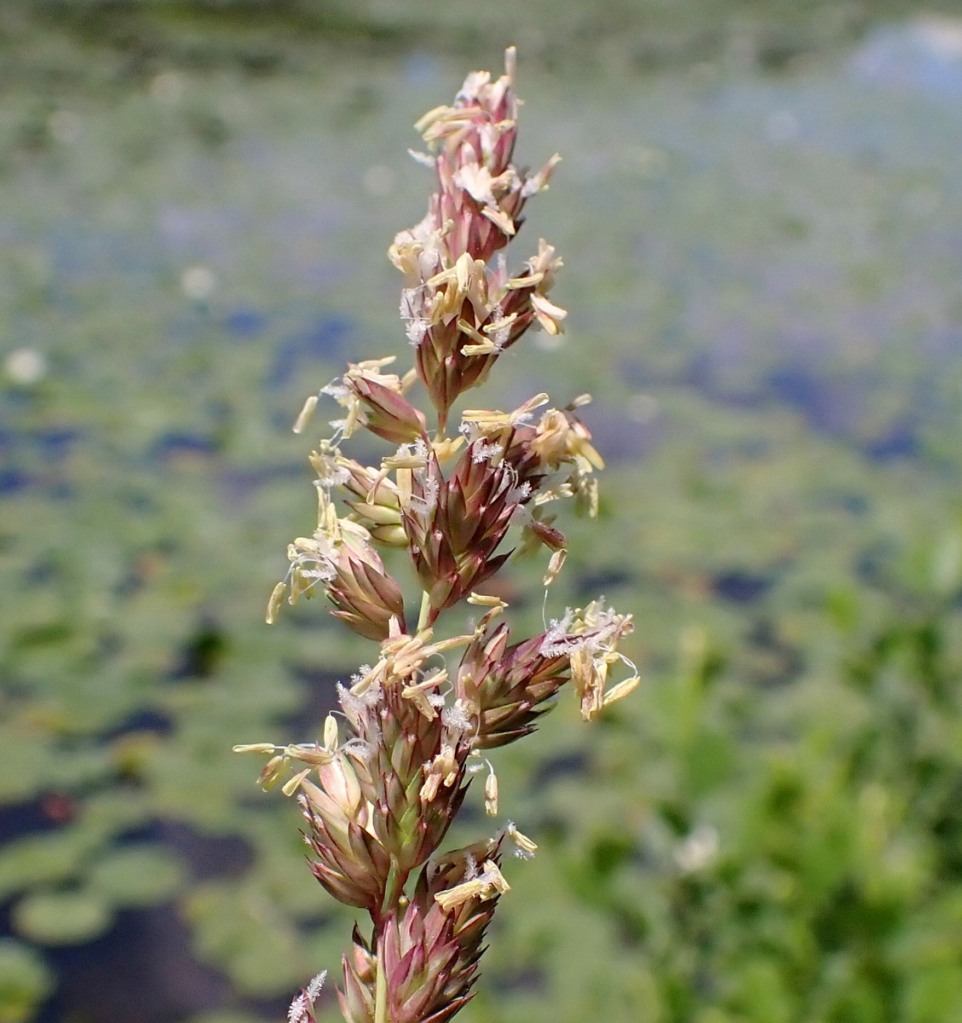
There are many grasses starting to flower now and I hope you’ll go out and see them. Never mind your hay fever; I have allergies too. Nature doesn’t mind being sneezed at. Take a pill, grab some tissues and become one of those who sees the beauty that most never see. Even if you have to see it through watery eyes now and then, it’s still beautiful.

A native smooth carrion flower vine (Smilax herbacea) grew beside a trail and it seemed as if it just flung itself into existence and went wild, with leaves and tendrils and great arching stems everywhere. I thought it was a beautiful thing, and it stopped me right in my tracks. No matter what is going on in life, no matter where you are, there is always beauty to be seen. You don’t even have to search for it; it is just there, like a dandelion blooming in a crack in the sidewalk as you hurry along, or a white cloud floating across a blue sky reflected in the glass of your car window. It is there I think, to remind us to just slow down a little and appreciate life more; to take the time to enjoy this beautiful paradise that we find ourselves in.
If you Love all Life you observe, you will observe all Life with Love. ~Donald L. Hicks
Thanks for stopping in.